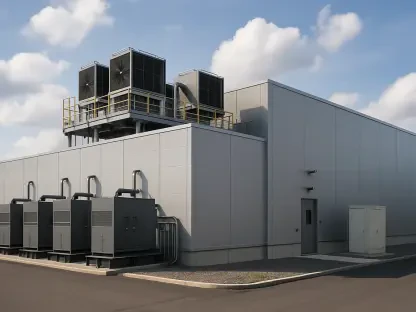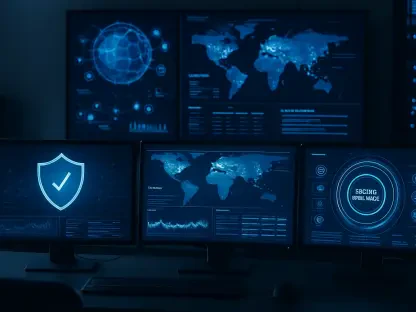The rapid pace of cloud adoption has significantly revolutionized business operations, presenting organizations with unique security and compliance challenges. This transformation demands stringent cybersecurity controls, as both the regulatory and threat landscapes have evolved rapidly. Chief Information Security Officers (CISOs) are now faced with managing large portfolios of applications across increasingly complex environments. Traditional tools have become outdated, necessitating the adoption of sophisticated solutions such as continuous controls monitoring (CCM) and the integration of artificial intelligence (AI). This article explores how organizations can modernize security and compliance in evolving cloud environments.
Challenges of Rapid Cloud Adoption
Complexity and Governance
Cloud environments are inherently complex and require robust governance mechanisms. Traditional governance, risk, and compliance (GRC) tools simply haven’t kept pace with these new demands. As a result, they produce outdated and incomplete reports that fail to provide the necessary oversight. Modern cloud environments demand continuous monitoring and a more agile approach to compliance. Given the rapid changes in cloud services, CISOs must adapt quickly to ensure robust security and compliance. The sheer number of services and the speed at which they evolve require a modernized approach to governance that leverages automated, real-time monitoring.
Moreover, managing governance in these dynamic environments is not just a technical challenge but also a strategic one. Organizations must balance the need for innovation with the necessity of maintaining a strong security posture. This balancing act involves integrating security and compliance into the very fabric of cloud operations. Comprehensive governance mechanisms are vital to understanding, managing, and mitigating risks in real time. Failure to modernize governance practices can leave organizations exposed to not just operational risks but also compliance penalties.
Ephemeral Environments
Cloud services, particularly serverless architectures, dynamically scale up and down based on demand. This dynamism poses significant challenges in maintaining consistent asset inventories, making it difficult to track and monitor resources. Automated solutions for evidence gathering and compliance demonstration become critical in such environments. Without automation, the ephemeral nature of cloud resources can lead to substantial gaps in compliance and security. In these settings, manual methods for maintaining inventories and ensuring compliance are simply inadequate. They not only consume valuable time but also introduce significant scope for human error.
Furthermore, the transient nature of serverless architectures means that traditional methods for evidence collection and audit trails are ineffective. Automated tools designed for cloud environments can capture the necessary data in real time, ensuring that compliance is maintained even as the underlying infrastructure changes rapidly. These tools can provide continuous visibility into resource allocations, usage patterns, and security postures, allowing organizations to respond swiftly to any deviations from compliance norms.
Hybrid and Multi-Cloud Environments
Many organizations today operate in hybrid and multi-cloud environments, adding further layers of complexity to their security and compliance efforts. Managing security and compliance across varied landscapes is immensely challenging. Organizations require tools that provide unified oversight to navigate these complexities effectively. A unified approach allows for holistic analysis and evaluation of risk across the entire cloud ecosystem. Such an approach ensures that security protocols and compliance measures are consistently applied, regardless of the underlying cloud platform.
The heterogeneity of hybrid and multi-cloud environments introduces a variety of risks and compliance requirements, each dictated by the specific characteristics of the platforms used. To manage these complexities, organizations must adopt solutions that can integrate seamlessly across different cloud providers. These solutions should offer consistent visibility and control, enabling organizations to maintain a coherent security posture and meet regulatory requirements.
Cloud-Native Compliance
Automation and Continuous Monitoring
Traditional regulations were designed for static infrastructure and have struggled to keep up with the fluidity of modern cloud environments. With the widespread adoption of cloud services, these regulations have had to evolve. New frameworks like the General Data Protection Regulation (GDPR) and the California Consumer Privacy Act (CCPA) specifically address data privacy concerns in the cloud. Continuous controls monitoring (CCM) is essential for automating risk assessments and compliance workflows, ensuring that compliance is an integral part of cloud operations. CCM enhances security protocols by enabling continuous, real-time monitoring of cloud environments.
Automation of compliance tasks through CCM can significantly reduce the burden on compliance teams, allowing them to focus on more strategic activities. Automated tools can scan for compliance violations, generate reports, and even remediate issues without human intervention. This reduces the time lag between identifying a compliance issue and resolving it, thereby minimizing potential risks.
Unification of Tools and Data Sources
CCM tools can unify disparate tools, controls, and evidence across various environments, enabling a more holistic analysis and evaluation of risk. By consolidating data points across different platforms, these tools provide comprehensive oversight, allowing organizations to make more informed decisions. Real-time data analysis facilitated by CCM tools enhances the accuracy of compliance and security assessments, making it easier to spot and address vulnerabilities promptly.
The unification of tools and data sources also streamlines the compliance management process. Organizations can eliminate the silos that traditionally exist between different compliance activities, leading to a more integrated approach. This unification allows for better coordination between security and compliance teams, ensuring that both functions are aligned. The result is a more robust compliance posture that can adapt quickly to the changing regulatory landscape.
Compliance as Code
The concept of compliance as code shifts traditional compliance processes towards a modern DevSecOps approach. Standards like the Open Security Controls Assessment Language (OSCAL) from the National Institute of Standards and Technology (NIST) facilitate this shift, allowing for machine-to-machine attestation and real-time visibility into compliance procedures. Compliance as code modernizes compliance processes and seamlessly integrates them into cloud operations, making compliance more proactive and less reactive.
By embedding compliance into the development and operational workflows, organizations can ensure that security and compliance checks are part of the software development lifecycle. This not only reduces the risk of non-compliance but also improves the overall security of applications. Compliance as code enables automated, real-time updates to compliance requirements, ensuring that organizations are always in line with the latest regulatory standards.
Artificial Intelligence and Compliance
Enhanced Capabilities
Artificial intelligence (AI) introduces both opportunities and challenges in the realm of compliance. AI can automate tedious compliance-related tasks, such as writing policies and drafting control implementation statements. Additionally, AI enables predictive analytics and gap detection, invaluable for staying ahead of emerging threats. These capabilities enhance the overall efficiency and effectiveness of compliance efforts, making it easier to maintain a robust compliance posture even as the threat landscape evolves.
The use of AI in compliance also allows organizations to leverage advanced analytics to identify patterns and trends that may indicate risks. By analyzing large volumes of data, AI can provide insights that would be difficult, if not impossible, to obtain through manual methods. These insights can be used to fine-tune compliance programs, making them more effective at mitigating risks.
New Threat Vectors
While AI offers significant advantages, it also introduces new attack surfaces. Both external malicious actors and internal negligence can exploit these vulnerabilities, posing new risks to organizations. To manage these risks, organizations need sophisticated tools designed to leverage AI securely. These tools must ensure that the benefits of AI are harnessed without compromising security. This involves implementing robust security measures specifically designed to protect AI systems from being compromised.
The introduction of AI into compliance processes can also lead to unintended consequences if not managed properly. For example, reliance on AI for decision-making could result in biased outcomes if the underlying algorithms are not properly validated and monitored. Organizations must establish clear guidelines and oversight mechanisms to ensure that AI is used ethically and responsibly.
Regulatory Evolution
As AI adoption grows, regulatory frameworks will inevitably expand to govern its use, adding to the compliance burden on organizations. Tools must be capable of integrating these new regulations seamlessly, ensuring that AI implementations remain compliant as the regulatory landscape evolves. Organizations must stay ahead of these changes to avoid potential compliance pitfalls and ensure that their use of AI is both effective and compliant with applicable regulations.
Keeping pace with regulatory changes requires a proactive approach. Organizations must regularly review and update their compliance programs to reflect the latest regulatory requirements. This involves not only understanding the regulations but also implementing the necessary changes in a timely manner. By staying ahead of regulatory changes, organizations can minimize the risk of non-compliance and ensure that their AI implementations are secure and effective.
Overarching Trends and Consensus Viewpoints
Need for Modernized Tools
There is a broad consensus on the necessity of modern tools to manage the complexities of cloud environments. Traditional methods are woefully inadequate for today’s dynamic settings, and organizations must adopt continuous monitoring and compliance-as-code practices to keep pace with evolving threats and regulations. These tools provide the agility and responsiveness needed to manage compliance and security in real-time, ensuring that organizations can stay ahead of potential risks.
Modernized tools also offer the scalability required to manage large-scale cloud environments. As organizations continue to expand their cloud footprints, the need for scalable, automated compliance solutions will only grow. These tools can provide the necessary visibility and control to manage compliance effectively, regardless of the size or complexity of the cloud environment.
Integration of AI
The role of artificial intelligence in compliance and security is increasingly prominent. While AI offers numerous benefits, its integration must be managed carefully to mitigate new risks. Organizations must balance the advantages of AI with the need for robust security measures. This involves implementing appropriate controls and oversight mechanisms to ensure that AI is used effectively and responsibly.
The integration of AI into compliance processes also requires a cultural shift. Organizations must embrace a more data-driven approach to compliance, leveraging AI to gain deeper insights and make more informed decisions. This shift involves not only adopting new technologies but also rethinking traditional compliance strategies.
Unified Approach
A unified approach to security and compliance is essential for success in evolving cloud landscapes. Leveraging tools like continuous controls monitoring, organizations can consolidate various data points and provide comprehensive oversight. This unified approach prepares organizations to meet future challenges and ensures the protection of digital assets. By adopting a more integrated approach, organizations can achieve greater efficiency and effectiveness in their compliance efforts.
The unified approach also facilitates better collaboration between different teams within the organization. Security, compliance, and IT teams can work together more effectively, leveraging shared tools and data to achieve common goals. This collaboration is critical for maintaining a strong security posture and ensuring compliance with regulatory requirements.
Conclusion
The rapid speed of cloud adoption has dramatically transformed business operations, bringing about unique security and compliance challenges. As companies migrate to cloud environments, the pressure to implement stringent cybersecurity controls increases, especially with the regulatory and threat landscapes evolving so quickly. Chief Information Security Officers (CISOs) must now manage extensive portfolios of applications in increasingly complex settings. Traditional tools are no longer sufficient, compelling the need for advanced solutions like continuous controls monitoring (CCM) and artificial intelligence (AI) integration.
This new landscape requires organizations to adopt more sophisticated security and compliance strategies to keep up with the evolving demands. The push towards cloud computing means businesses need to rethink their approaches to security, moving away from outdated methods to incorporate cutting-edge technologies. These advanced tools provide real-time monitoring and automated threat detection, ensuring that compliance standards are met while protecting sensitive data from cyberattacks. This article delves into how organizations can modernize their security and compliance practices in an age of rapid cloud adoption, ensuring they stay ahead in a constantly shifting environment.









